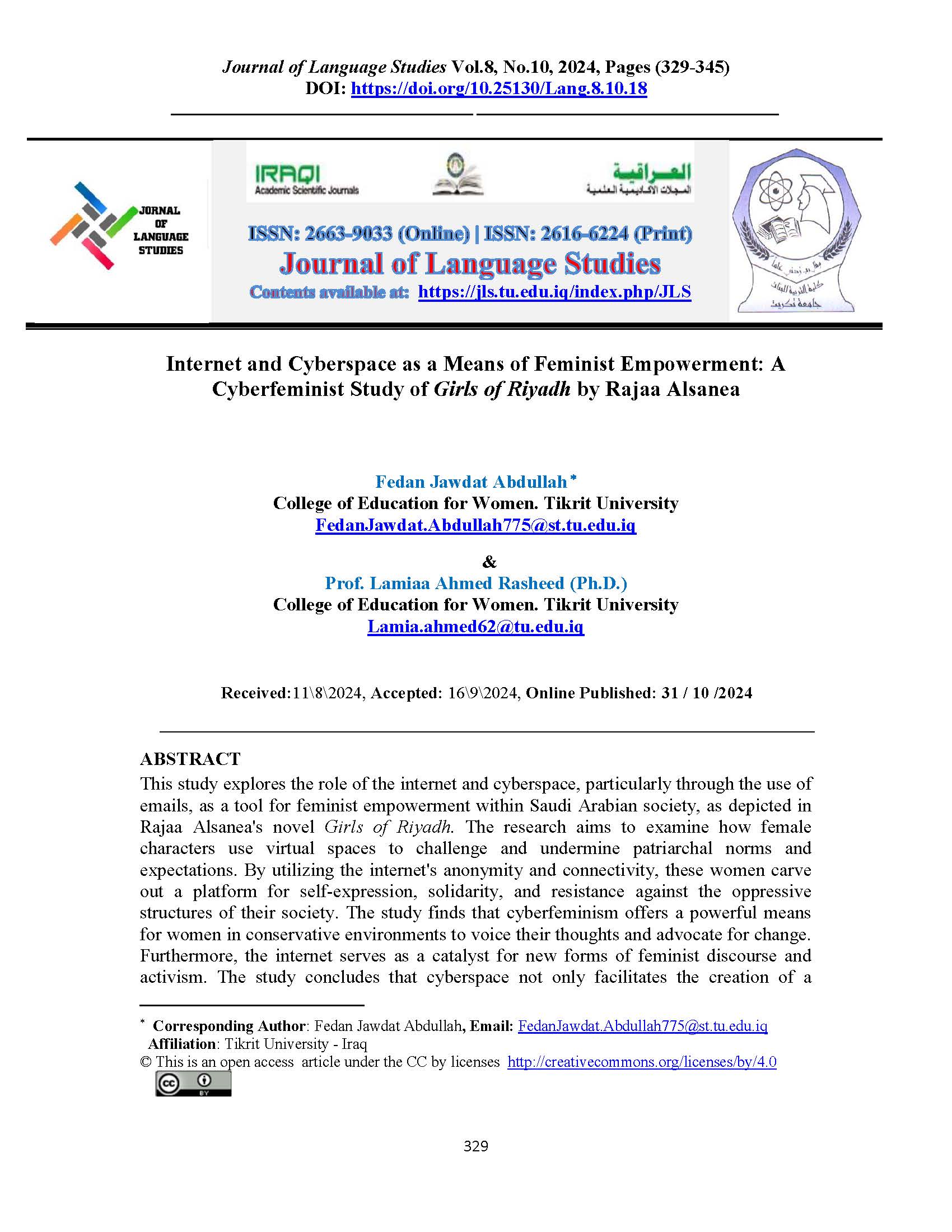Internet and Cyberspace as a Means of Feminist Empowerment: A Cyberfeminist Study of Girls of Riyadh by Rajaa Alsanea
Fedan Jawdat Abdullah
College of Education for Women. Tikrit University
Lamiaa Ahmed Rasheed
College of Education for Women. Tikrit University
DOI: https://doi.org/10.25130/Lang.8.10.18
Keywords: Cyberfeminism, Cyberspace, solidarity, Emails, Rajaa Alsanea’s Girls of Riyadh
Abstract
This study explores the role of the internet and cyberspace, particularly through the use of emails, as a tool for feminist empowerment within Saudi Arabian society, as depicted in Rajaa Alsanea's novel Girls of Riyadh. The research aims to examine how female characters use virtual spaces to challenge and undermine patriarchal norms and expectations. By utilizing the internet's anonymity and connectivity, these women carve out a platform for self-expression, solidarity, and resistance against the oppressive structures of their society. The study finds that cyberfeminism offers a powerful means for women in conservative environments to voice their thoughts and advocate for change. Furthermore, the internet serves as a catalyst for new forms of feminist discourse and activism. The study concludes that cyberspace not only facilitates the creation of a collective feminist identity but also empowers women to redefine their roles and resist traditional societal constraints.
References
Alsanea, R. (2007). Girls of Riyadh (M. Booth, Trans.). Penguin Books.
Altman, J. (1982). Epistolarity: Approaches to a form. Ohio State University Press.
Banet-Weiser, S. (2018). Empowered: Popular feminism and popular misogyny. Duke University Press.
Bendouma, N., & Kerboua, S. (2023). Islamic feminism at the crossroads between apologetics and defending women: Rajaa Alsanea’s Girls of Riyadh in context. Journal of International Women's Studies, 25(1), Article 11. https://vc.bridgew.edu/jiws/vol25/iss1/11
Daniels, J. (2009). Cyberfeminism: The intersection of gender and technology in contemporary cultures. Routledge.
Doumato, E. A. (2000). Getting God's ear: Women, Islam, and healing in Saudi Arabia and the Gulf. Columbia University Press.
Gajjala, R. (2002). Cyberfeminism and community building: A critical reflection on approaches to Systers. New Media & Society, 4(2), 291–312. https://doi.org/10.1177/14614440222226207
Giti, S., & Mohajeri, M. (2020). A study of feminist ideas in The Girls of Riyadh novel by Rajaa Al-Sanea based on Simone de Beauvoir theories. Revista Cubana de Investigaciones Biomédicas. http://scielo.sld.cu/scielo.php?pid=S2218-36202020000100251&script=sci_abstract&tlng=en
Haraway, D. (1985). A manifesto for cyborgs: Science, technology, and socialist feminism in the 1980s. Socialist Review, 80, 65–108.
Haraway, D. (1991). A cyborg manifesto: Science, technology, and socialist-feminism in the late 20th century. In Simians, cyborgs and women: The reinvention of nature (pp. 149–181). Routledge.
Herring, S. C. (2003). Gender and power in online communication. In J. Holmes & M. Meyerhoff (Eds.), The handbook of language and gender (pp. 202–228). Wiley.
Ichsan, H. (2021). Building identity in global reality: A postcolonial study on Rajaa Alsanea’s Banat Ar-Riyadh. Jurnal Poetika, 9(1), 23. https://doi.org/10.22146/poetika.v9i1.63956
Khalifa, N. S. (2019). Internet chat as ‘jargon’. Journal of Language Studies, 3(1), 121-132.
Le Renard, A. (2008). Only for women: Women, the state, and reform in Saudi Arabia. Middle East Journal, 62(4), 610–629.
McRobbie, A. (2009). The aftermath of feminism: Gender, culture, and social change. SAGE Publications.
Mendes, K., Ringrose, J., & Keller, J. (2018). #MeToo and the promise and pitfalls of challenging rape culture through digital activism. European Journal of Women's Studies, 25(2), 236–246. https://doi.org/10.1177/1350506818765318
Nakamura, L. (2002). Cybertypes: Race, ethnicity, and identity on the Internet. Routledge.
Plant, S. (1997). Zeros + ones: Digital women and the new technoculture. Doubleday.
Saeed, A. H., & Rasheed, L. A. (2024). Women at War: A Feminist Study of Militarism in Gayle Tzemach Lemmon’s Daughters of Kobani. JOURNAL OF LANGUAGE STUDIES, 8(4), 111-123.
Senft, T. M. (2008). Camgirls: Celebrity and community in the age of social networks. Peter Lang.
Shihada, I. (2013). Breaking silence in Rajja Al-Sanea’s Girls of Riyadh. ResearchGate. https://www.researchgate.net/publication/236666886_BREAKING_SILENCE_IN_RAJJAALSANEA'S_GIRLS_OF_RIYADH
Tufekci, Z. (2017). Twitter and tear gas: The power and fragility of networked protest. Yale University Press.
Turkle, S. (1984). The second self: Computers and the human spirit. Simon & Schuster.
VNS Matrix. (1991). A cyberfeminist manifesto for the 21st century. VNS Matrix Manifesto. Retrieved from https://vnsmatrix.net/
Wajcman, J., & Young, E. (2023). Feminism confronts AI: The gender relations of digitalisation. In J. Browne et al. (Eds.), Feminist AI: Critical perspectives on algorithms, data, and intelligent machines (online edn). Oxford Academic. https://doi.org/10.1093/oso/9780192889898.003.0004

